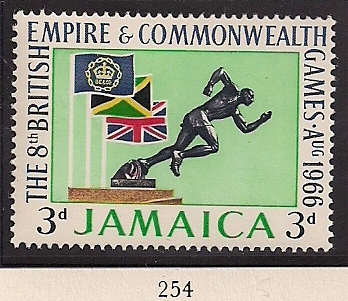
Four years after independence, larger countries had doubts over whether Jamaica’s infrastructure and personnel would be able to manage such a large international event, but by Elizabeth II, did they pull it off!
Whilst England was basking in the glory of their victory over Germany in the 1966 World Cup, a former colony of the British Empire was preparing for their year of glory as the host nation of the 8th British Empire and Commonwealth Games and the 2nd Commonwealth Paraplegic Games.
Jamaica, the land of wood and water was once the crown jewel of the British Empire, generating great wealth for British planters from the production of sugar during the Atlantic slave trade during the 17th and 18th century. After the abolition of slavery, Jamaica remained under the rule of the British Empire until 6th August 1962 when they gained independence and became part of the British Commonwealth.
Independence bought great expectations to the 146 mile long island, and with great expectations came great responsibility. As festivities filled the island with new hopes and aspirations, plans were already underway to firmly put Jamaica on the map, showcasing the former gem of the British Empire to the world as an example of independent economic growth and social stability. What other place best to do that other than the British Empire and Commonwealth Games, second only in importance to the Olympics.
The campaign to host the games began in 1960 and was led by Herbert Macdonald, president of the organising committee for the games, together with George Abrahams, the director of the organisation of the games; they travelled to Perth, Australia in 1962 to secure the bid, successfully winning more votes than their rivals Scotland, to become the smallest and first nation to host the Games outside the ‘White Commonwealth’.
Let the Games Begin!
The next four years were crucial to Jamaica’s new independence status. Jamaican authorities had invested a great deal of energy and resources in securing the event and developments of Kingston, Jamaica’s capital city began with the construction of a National Stadium at the sport and cultural complex, Independence Park as a monument to Jamaica’s independence and to accommodate independence celebrations which were officiated by Her Royal Highness, Princess Margaret on 4th August 1962. When the games approached in 1966, the venue was able to hold 35,000 spectators and was the natural choice to host the opening and closing ceremonies, all track and field events, cycling, and the semi-finals and finals of the boxing tournaments. Independence Park boasts the Commonwealth Game specification swimming pool at 50 metres, which had to be enlarged specifically for the 1966 games, tennis courts and practice fields, all of which were utilised for the games and is also home to the National Arena- Independence park, a venue which still stands today.
The Games Village
Approximately four miles from all the games action at the National Stadium lays the historic site of two former sugar estates, the Mona and Papine estates which were active in the latter half of the 18th century slave trade. The site has seen many changes to its landscape over the centuries, and in 1966 it became the official Commonwealth Games Village, home for the 34 nations and over 1000 athletes that participated in the games.
Today you may know it as the University of the West Indies. In the development stages of the University, a modernised halls of residence were built and it was in those newer halls that the athletes who took part in the games, were housed.
Little is known about the Commonwealth Games Village as there are not many records to be found surrounding the event, however it is well documented that the site was also host to most of the disabled Athletes who took part in the Paraplegic Games between August 14th and August 20th. Whilst the Paraplegic games did not take place in the National Park, they did take place on the playing fields at Mona, the pool, gymnasium, and the old library. It is clear the University of the West Indies at Mona, contributed significantly to the overall success of both games.
Although Jamaica is the first host nation to not secure a gold medal at a Commonwealth Games, they did secure four silvers and eight bronze medals.
Today the venues that that once hosted the paraplegic games and housed over 1000 athletes in 1966, is now home of Glen Mills’ world famous ‘Racers Track Club’ training ground to the Jamaican triple world record holder, and the world’s fastest man, Usain Bolt.
Miranda La Crette is an Archives Assistant at the University of the West Indies and a Freelance writer.
